The Strange Time-Warp Case of Corporal Armando Valdés

Most countries have a single UFO case that seems to overshadow all others in terms of fame, longevity, and controversy. For instance, the U.S. has the Roswell incident and England has the Rendlesham Forest close encounters. The country of Chile is no different, where the strange time-warp story of Corporal Armando Valdés and seven soldiers of the Chilean Army have long dominated the local ufological scene. The incident occurred in 1977 in a desolate mountain desert site called Pampa Lluscuma, near the town of Putre in Chile’s northern Tarapacá region.
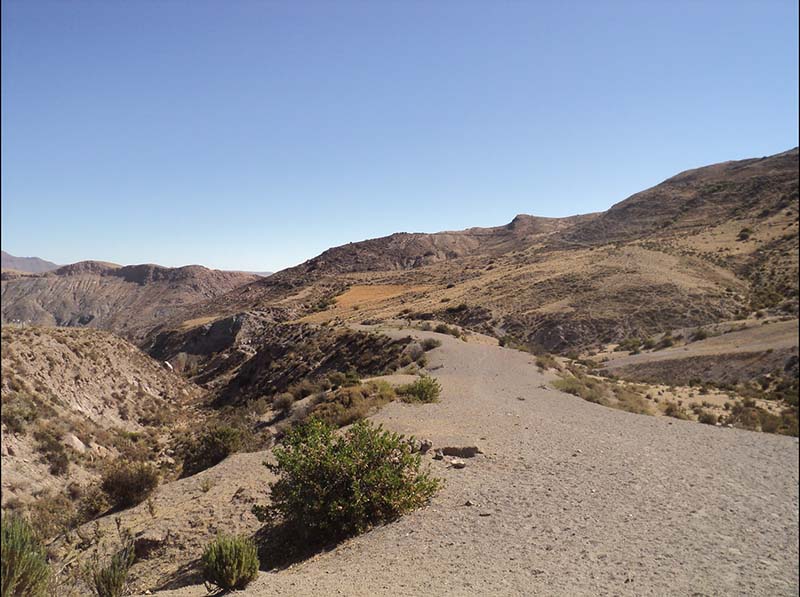
This case occurred in one of Chile’s so-called zonas calientes (“hot zones”) for UFO sightings, but what distinguishes it from all other close encounters is that the main witness, Corporal Valdés, apparently experienced physiological and mechanical effects after disappearing for about fifteen to twenty minutes—presumably taken inside a huge luminous globe hovering near the soldiers. The corporal reappeared in a state of shock. The strangest part of the story is that, upon his return, Valdés had a five-day growth on his beard and his wristwatch had stopped after the short experience but its calendar showed five days in the future, April 30, 1977 instead of the actual date of April 25. These effects made the case truly unique. It’s also noteworthy that the Chilean Army didn’t disavow the incident and, on the contrary, allowed the publication and broadcast of interviews with Valdés and the soldiers.
The Valdés incident triggered an unprecedented wave of public interest in Chile and, to a lesser extent abroad, where it was covered by the French news agency Agence France-Presse, and the U.S. tabloid, the National Enquirer. A drawing of a disheveled corporal even appeared in the Ripley’s Believe It or Not! book series.

The Basic Facts
Date: April 25, 1977.
Location: Stables of the Chilean Army in Pampa Lluscuma, a mountainous desert site in northern Chile. The nearest town is Putre in the foothills of the Andes, about 150 kilometers to the west of the Port of Arica.
Time: The UFO was first spotted at 3:50 a.m. by a soldier on guard duty at a Chilean Army stable, who immediately alerted his leader, Corporal Valdés, and his six other companions. The UFO hovered close to the ground at a distance of about 500 meters from the soldiers. At approximately 4:15 a.m., the corporal decided to investigate it himself. He disappeared for fifteen minutes, returning at 4:30 a.m. and immediately lapsing into semi-consciousness. He regained consciousness at around 7:00 a.m. The UFO stayed on the scene until dawn, taking off at 6:35 a.m.
Witnesses: Twenty-three-year-old Corporal Valdés, who then had five years of service in the Chilean Army, was accompanied by seven conscripts from the Rancagua Regiment, which was under the command of the Huamachuco Brigade based in Arica.
Investigation: The initial investigation of the event was conducted by Pedro Araneda, a school teacher in Putre. Araneda was the first person to encounter the baffled soldiers when they returned to Putre following the UFO encounter. Araneda immediately returned to the scene of the incident with the witnesses, where he proceeded to tape record a long interview with all of them. He was later quoted saying,
I was surprised at the corporal’s appearance. He had around six to seven days’ growth of beard. I knew soldiers have to shave every day. It was obvious that the soldiers had been through some kind of extraordinary experience. Even two or three hours after it happened, they were all still in a state of complete shock, I would say, near panic. And all the men told me the same story.
To this day, Araneda’s classic interview remains the original, comprehensive first-hand source for the case.

Dissemination: For a few days, the military governor of Arica censored publication of Araneda’s sensational tape in the local newspaper, La Estrella de Arica, in order “to avoid speculations and unmeasured commentaries lacking scientific basis,” according to the official communiqué at the time. This was during the early years of General Augusto Pinochet’s military regime in Chile, a time when media censorship was common. However, since this was not a political story, the press insisted and extended excerpts of the tape were finally published in the local Arica newspaper. On May 19, 1977, the story appeared on the front page of El Mercurio, the country’s most prestigious and influential newspaper. As a result of the widespread publicity, the Chilean Army’s Chief Command eventually issued a formal statement which, significantly, confirmed the accuracy of the reports published by the press. The communiqué added, somewhat cryptically, “The Army does not pronounce itself with regard to the facts described by members of the patrol.”
Later Developments: No significant new evidence about the case emerged until the late-1990s, when a couple of the soldiers were located by ufologists and were eventually interviewed for a UFO series broadcast on Chile’s national television network TVN. The seven soldiers who witnessed the close encounter in 1977 had long left the service; only Valdés had remained in the army, where he was promoted to sergeant and finally retired in 1999. Valdés himself appeared on a primetime popular talk show on TVN right after his retirement. He continued to reaffirm the validity of the experience, as did the other soldiers, although various aspects were clarified and some new things revealed. A new investigation was launched in 2002 by two Chilean researchers, journalist Patricio Abusleme and skeptic Diego Zúñiga. They located most of the original witnesses, and some of them agreed to be interviewed formally.
It was in the course of this investigation that Valdés dropped a bombshell in a recorded interview with Abusleme, recanting a crucial part of the story. He continued to stick to the story of the ball of light hovering near the soldiers, but he informed Abusleme that he never disappeared inside the UFO. He claimed that he left the soldiers to urinate and then stayed behind a wall throughout the key fifteen to twenty minutes of his alleged disappearance. He now said that he decided then to play a prank on the soldiers by pretending he had vanished. He explained the growth of the beard saying he hadn’t shaved for several days. He also said that his wristwatch wasn’t working, and the date change was just a coincidence.
However, Valdés’s confession is not as simple as it seems. For one, the other soldiers still support the original version. Then, there is the additional important factor that Valdés became a devout evangelical Christian many years ago, a member of the Unión de Centros Bíblicos of Temuco, of which he is now a bishop. One can argue the denial on the part of Valdés is based on his religious faith, a position which Abulesme himself considers plausible.
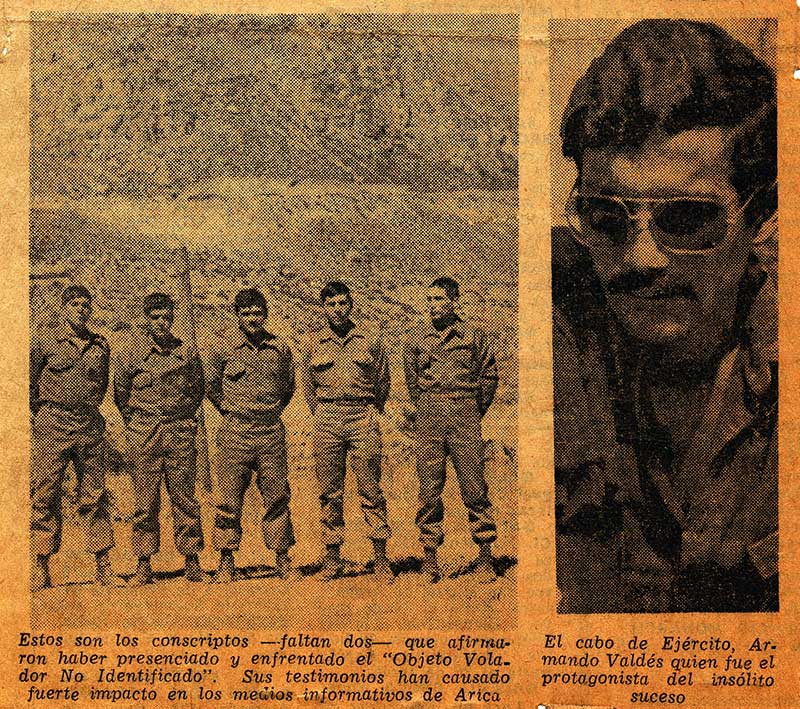
The Original Version
Like many famous UFO cases, such as Roswell, the Valdés affair has become somewhat of a myth. Many rumors and wild tales were added over the years, including that some of the soldier’s rifles were bent mysteriously and that there were other military patrols involved as part of secret maneuvers with the Israelis. None of these stories were proven true. Valdés himself had a second UFO sighting in 1980 and also hinted in the TVN interview of encountering mysterious “Men in Black,” throwing eschatological tidbits here and there. For these reasons, it is important to rely on the original recorded interview made by Pedro Araneda just a couple of hours after the close encounter, a very unusual and lucky circumstance in UFO investigations.
One thing that was censored by the military in all the original newspaper articles is that Corporal Valdés was not in charge of a patrol, as was stated in the press reports, but his small unit was instead guarding a large army stable with hundreds of horses. Horses are the best way to move around fast in the rugged terrain near Putre, but because Pampa Lluscuma was located close to the border with Peru and there were border tensions in 1977, the location of the stables was considered a military secret. Thus, the military created a cover story of a routine army patrol.
The incident begins on April 25, 1977, at 3:50 a.m., in the cold and desolate area of Pampa Lluscuma, when the night watchman, known only as Private Rosales, first spotted what looked like two stars descending over a nearby hill. Rosales immediately alerted his superior, Corporal Valdés, as well as the other six soldiers who were resting near a campfire. As soon as the corporal saw the lights, he extinguished the campfire, and all seven soldiers gathered in shoulder-to-shoulder combat position, suspecting the lights were a smuggling plane. But, the soldiers soon realized there was much more to it than that. Their rifles could not stop what they described in the Araneda tape as an object “round as a ball . . . half oval . . . expanding and contracting, with a violet halo, like a cloud or a fog, with two flashing orange lights on either side.”
One of the UFOs descended extremely slowly to the ground, at a distance of about 500 meters from the military patrol. An interesting side note is that all the animals in the area, including the horses, the patrol’s dog, and a nearby flock of sheep, supposedly were paralyzed by the presence of the object and became totally silent. According to Corporal Valdés, “the hill was entirely illuminated by this object, and we could easily make out its contours and fields even though it was a pitch-black moonless night.” Likewise, there are reports that the patrol’s radio equipment malfunctioned, which together with the effect on the animals, the physiological changes in the corporal’s beard and the mechanical effects on his watch, make this case a classic Close Encounter of the Second Kind (CE-2).

In the original interview, the corporal says he screamed in the direction of the violet light, “Go away! In the name of God I order you to go!” In those moments, continued Valdés, “we were ready for anything, to die together if necessary. But nothing would separate us. We made an oath to stay together.” Yet despite the oath, Valdés left the group around 4:15 a.m. and started walking towards the light. He was later unable to recall his motives for leaving the group. “The only thing I can tell you,” he said to Araneda, “is that something terrible was calling my attention . . . something was attracting me . . . It was like an internal communication with the light.”
The other soldiers all said that, as Valdés walked towards the violet light, he suddenly disappeared. For the next fifteen-to-twenty minutes the soldiers were “yelling and calling him by name while the light was still there.” But, there was no response. The corporal’s return to the camp was almost as strange as his disappearance in that he suddenly emerged in a kind of somnambulistic state behind his companions. One of them later assured Araneda that “we didn’t hear his footsteps when he came back. Usually, you hear a person when he comes in the silence of the night.” Another soldier recalled that “for a few seconds the corporal looked at us as though he didn’t know us, and moving his head backwards and forwards, he was saying, ‘the light . . . the light’.” Valdés remained in this state until 7:00 a.m. (the UFO had taken off at 6:35 a.m.), and the soldiers reported that at intervals he would exclaim in a strange voice something like, “You don’t know who we are nor from where we come, but I tell you we will return soon!”
Two specific details were noticed by the soldiers, which would make this case a cause célèbre in ufology for its sheer strangeness. First, the corporal had a five-to-seven day growth of beard, even though he had shaved the previous morning. Second, his watch had stopped at 4:30 a.m. (the time he returned from the UFO) yet the calendar on his digital watch was five days in advance, reading April 30 instead of April 25, the actual date.
Valdés insisted that his mind was completely blank as to what happened during the brief time he was missing. He only remembered walking towards the strange light. He told Araneda:
From there on, I lost all sensations. The soldiers told me I disappeared, as though by magic. The only thing I remember, what appears in my mind, is something like the sensation I have when I am extremely sleepy . . . I seemed to disappear into a deep well, something round, an abyss . . . from there my mind is void.
At another moment in the tape, Valdés said that the event was “extraordinary, and I tell you that we are eight minds . . . It’s possible for one person to suffer a hallucination, an apparition, but here eight people are saying the same thing.” He went on, “What I don’t remember is what happened to me. I only know what the soldiers told me.” But he also told Araneda he thought the whole thing was a warning, that whatever was behind that light “was trying to tell me that this was not the last time we were going to see each other.”

Those were the rough facts of the Valdés case as they were originally reported in the Chilean press on the basis of Pedro Araneda’s taped interview with the soldiers. Although the military governor of Arica censored the publication of the tape for a few days, large excerpts of it were finally published in La Estrella de Arica, El Mercurio, and other newspapers. This national flurry led to the Chilean Army issuing an official communiqué, which stated the following:
1. The army does not pronounce itself over the facts related by the members of the patrol.
2. From the moment in which the event took place until this was reported by the press, the institution (army) had not issued an official version.
3. In accord with consultations undertaken through official means, it is stated that the versions given by the press until this moment are generally coincident with the accounts from the members of the patrol.
Although the communiqué is written in a particularly cautious language, the main point is that the witnesses’ accounts published by the press were “coincident” to those given by the soldiers to their own army superiors. As Chile was then ruled by a military regime, no further data concerning a possible internal investigation was released by the army.
A Complex Case
Researcher Patricio Abusleme’s book, La noche de los centinelas (The night of the guards), is no doubt the definitive work about the case. It has a wealth of information, including transcriptions of all the original documents, newspaper articles, and the more recent interviews conducted by him and his colleague Diego Zúñiga. Abusleme explains in his book that initially he was happy to accept the recantation of Valdés: “When I started to investigate methodically and go deeper into various aspects of the night of the guards, I had the secret hope that I would be able to explain the whole episode in conventional terms.” Zúñiga, on the other hand, accepted the recantation, writing a long article about it, “Satanic Abduction: Corporal Valdés Rewrites the Most Incredible Story of Abduction Known in Latin America,” with his skeptical colleague, the well-known Argentinean journalist and longtime ufologist Alejandro Agostinelli.
However, in the end things are not clearly black and white. Abusleme wrote in his book,
As I continued my investigation, I was hoping to find testimonies which could corroborate and complement the new version of non-commissioned officer (Ret.) Valdés. However, to my surprise and bafflement, I only found testimonies which reaffirmed the original story, which coincided and complemented each other while refuting the current version of Valdés.
Humberto Rojas, one of the original soldiers who would go on to become a policemen for some thirty years until his recent retirement, confirmed all the basic facts contained in the original version of the story, including the beard and the watch. One of the main problems with Corporal Valdés’s new version is the growth of his beard. Military rules everywhere require that all enlisted personnel and officers must shave every day, and the Chilean Army, with its old German traditions and discipline, was particularly strict in the Pinochet era. That a corporal, who must show a good example of proper behavior to his soldiers, could go around without shaving for several days was just not allowed. Then, there is the wristwatch problem. If the watch wasn’t working, why did Valdés bother to put it on that day? Plus the extraordinary coincidence that the watch malfunctioned exactly at the time of the Pampa Lluscuma event, but the calendar demonstrated a date five days ahead.
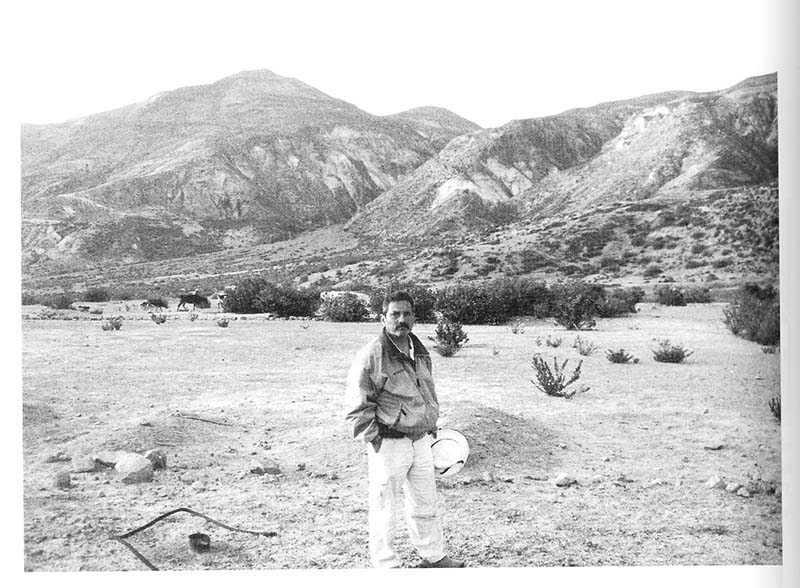
Yet another crucial problem is that the new version of the event doesn’t coincide at all with what Valdés told his superiors—first his commander in Arica and later doctors and psychologists at the military hospital in Santiago where he was under observation for several days. The psychological evaluations and recommendations written by Dr. Roberto Abarca and Captain Dr. Roberto Lailahacar Chavez (both published in Abusleme’s book) never mention the prank story, even though the reports were not at all sympathetic to the corporal. At that time, Valdés was clearly sticking to the original version, and the doctors tried to find psychological reasons for the experience. They recommended to the army that Valdés should be reassigned to a different unit and that “the [UFO] subject should not be discussed with him, and he should be forbidden to give interviews to the press and TV.” Despite all the problems and publicity, Valdés was not discharged from the army, but was instead reassigned to a regiment in the southern city of Temuco, where he still lives.
A final serious problem with Valdés’s new version is the behavior of Valdés right after the 1977 incident, which was attested by the seven soldiers and Pedro Araneda. Valdés was clearly affected by the experience, passing out and saying strange things. Unless he was a great actor, he seemed far more like someone who just experienced something truly unknown than a guy playing a prank.
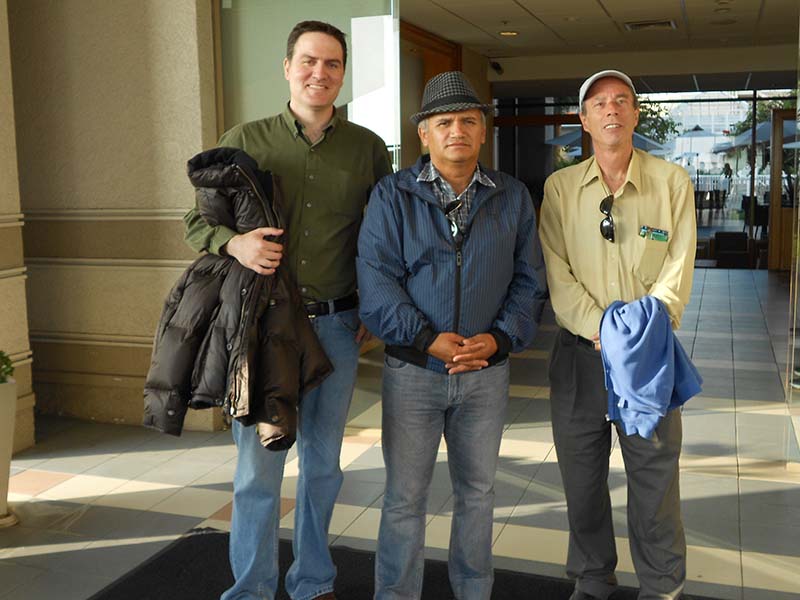
For all these reasons, I fully agree with Abuselme’s final conclusion that all the evidence “is pointing to a denial [by Valdés] of the possibility that UFO abductions could be real, in an attempt to fit his unusual experience with his religious convictions. On the other hand, he could be looking for an easy solution to end decades of being besieged by journalists.” In the end, the conflicting versions of the Valdés case show how difficult it is to prove conclusively that any UFO case is either unknown or prosaic. But regardless of what the final verdict may turn out to be in the Valdés case—if one is ever reached—there is no doubt that this close encounter is at least of great sociological importance in the history of Chilean ufology and, to a lesser extent, that of ufology in general.
This article originally appeared in Issue 19 (April/May 2013) of Open Minds Magazine.


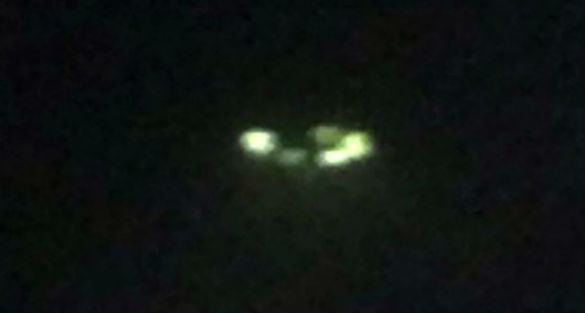


Hi! I’m Patricio Abusleme, the Chilean journalist and author mentioned in the article. I’m glad you finally published it online!
I know José Antonio Huneeus wrote the piece, but he appears as the person who posted the article on July 27, 2020. That is just a few days ago. Is Antonio working with Open Minds TV again? Are you in touch with him? Is he Ok?
I’m asking because here in South America (Chile and Argentina) we lost contact with him some years ago and there are some people worried about him and his well-being. I hope he’s doing well. He’s missed by some of his Chilean and Argentinian friends, colleagues and family members.
Cheers!
Hello! I actually posted this, but it was written by Antonio. I wish that said “author” instead of “posted by.” Antonio is still hard to get in touch with. I have to go to his house because he does not answer his phone or emails. He is still in AZ and I am in CA, so I have not seen him in awhile. But next time I go back – which may be next week – I will check on him.
It was in the early 1950’s when listening to a country western radio program called the Cottonseed Clark Show. All of a sudden Clark Interrupted the broadcast and said folks go out right now and look up, I’m looking out my window right now and there’s a big silver flying saucer just hvering go out now! We lived in a trailer park in Santa Clara Ca. and everyone who was listening to the station was out looking up, this thing came right over my head and stayed there, there was no sound or wind. When it started to rise it went straight up then pull away from us. Moffit Field Navil Air Station deployed the Fighter Jets to investigate and as the Jets got close to the UFO it literally shot straight up out of sight.
My dad was stationed at Moffit Field and when he came home momma asked him about the UFO and he said it wasn’t anything and we didn’t know what we were talking about and he didn’t want to hear anything about it! We were never to mention it around him again. The Navy was tight about the sighting.. However my dad couldn’t shut everyone in the trailer park that saw it and the talk continued for as long as we lived there which was a little over two years. When he was transferred to the Base in Bremerton Washington and the neighbors found out where we came from they asked us about the UFO, we talked about it when daddy wasn’t around.